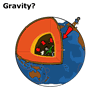"What goes up, must come down"
Sir Isaac Newton was 20 at the time when he is said to have been sitting in his garden in Lincolnshire and saw that famous apple fall from a tree.

|
Newton's apple |
Newton is said to have wondered why the apple which he had seen fall should move towards the Earth. It occurred to him that there must be a force acting on the apple. This force was the gravitational force of Earth, and reasoning from this he was able to show, some fifteen years later, that the Moon moves around Earth because of the same force.
Newton's law of gravitation
Every mass attracts every other mass with a force that increases with
their masses, but decreases with the square of their distance apart.
The gravitational force is the result of matter having mass. Even the smallest atomic particle exerts a gravitational attraction on its neighbouring particles. The size or strength of the gravitational force is very small compared to the strength of the bonding between atoms in molecules, or the even stronger binding of particles in the atomic nucleus.
Gravitational forces can work over enormous distances. The atoms in the
Sun exert their gravitational attraction on the particles in Pluto. Our
own Sun is held by gravity in the Milky Way galaxy, and galaxies around
us influence our galaxy. It is not too much to say that all matter, no
matter how small, influences all other matter in the Universe, by exerting
a gravitational attraction.
In Newton's own words
(To be read only for historical insight. The mixture of old English
and terminology can confuse!)
"… hitherto we have explained the phenomena of the heavens
(planetary motion) and of our sea (tides) by the power of gravity, but
have not yet assigned the cause of this power. This is certain, that it
must proceed from a cause that penetrates to the very centre of the Sun
and planets, without suffering the least diminution of its force; that
operates not according to the quality of the surfaces of the particles
upon which it acts (as mechanical forces do), but according to the quantity
of the matter which they contain, and propagates its virtue on all sides
to immense distances, decreasing always in the duplicate proportions of
the distance." "Principia - 1726"
"If I have seen further, it is by standing on the shoulders of giants", said Sir Isaac Newton in a letter to Robert Hooke in 1676. As all scientists should be, he was modest, recognising that his work depended on the great work of others before him.
Gravity on Earth
As we stand on the surface of our planet all of the particles in our bodies
are attracted to all of the particles making up our Earth, and vice versa.
That is, our particles attract all other particles, as much as we attract
them - the feeling is mutual!
The net effect of all the attracting is that we feel a force of attraction towards the centre of the Earth of about 9.8 Newtons per kilogram. If it were not for the Earth's surface pushing up, to balance this downward force, we would accelerate towards the centre of the Earth at 9.8 m/s2. This is the effect of gravity at our Earth's surface. If we were to rise through the atmosphere, and out into space, our attraction to the Earth would gradually decrease, until we got far enough away that the effect would be very small and effectively nil.
Gravity in the Earth
 What about if we were to go down into a deep mine, towards the centre
of the Earth - would the attraction become greater as we approach the
centre of the Earth? No! In fact it would become less, until at the centre
it would truly be zero. At the very centre of the Earth all of its matter
would be above you in all directions, so you would be attracted in all
directions away from the centre.
What about if we were to go down into a deep mine, towards the centre
of the Earth - would the attraction become greater as we approach the
centre of the Earth? No! In fact it would become less, until at the centre
it would truly be zero. At the very centre of the Earth all of its matter
would be above you in all directions, so you would be attracted in all
directions away from the centre.
Ah, but alas, the hot magma would have got you long before you could get near the centre of the Earth!
| Copyright owned by the State of Victoria (Department of Education and Early Childhood Development). Used with Permission. |